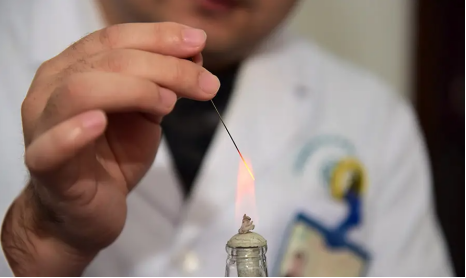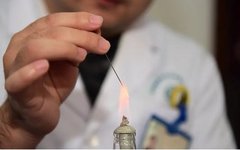
Fire needle therapy (huǒ zhēn liáofǎ) involves the use of specially designed needles that are heated and then quickly inserted into selected areas or acupuncture points. This technique is believed to stimulate the flow of qi (气), invigorate yang energy (阳气), and regulate the functions of the internal organs (脏腑), thereby ensuring the smooth flow of meridians (经络) and blood (血).


Effects of Fire Needle Therapy
1. Warms the meridians and promotes blood circulation. Fire needle therapy is effective in warming the meridians, promoting qi and blood flow, and alleviating pain. 2. Eliminates pus and necrotic tissue, and treats abscesses. Fire needle therapy shows significant efficacy in treating stubborn and severe abscesses, especially those that do not respond to medication, such as carbuncles, tumors, and phlegm-related conditions. 3. Softens hard masses and eliminates lumps. The unique characteristic of fire needle therapy is its ability to dissolve scars and masses formed by pathological accumulations of qi, blood, phlegm, and dampness. It is particularly effective for phlegm nodules, lymphadenopathy, and other similar conditions. 4. Warms and tonifies yang energy, and lifts sinking yang. Fire needle therapy enhances the body’s yang energy, stimulates qi flow, and regulates organ functions, thus strengthening yang and addressing deficiencies. 5. Reduces spots. In recent years, fire needle therapy has been used to treat facial spots, warts, moles, and excess flesh, achieving good cosmetic results. 6. Uses heat to expel heat. Fire needle therapy employs heat to open blocked pathways, allowing trapped heat toxins to be released, effectively treating conditions like mastitis, neck pain, back pain, mumps, and waist fire toxicity. 7. Activates blood circulation, resolves stasis, and alleviates swelling and pain.
Indications for Fire Needle Therapy
1. Pain-related diseases and conditions of yang deficiency;2. Skin diseases: Fire needle therapy stimulates the affected skin and blood vessels through heat, promoting vasodilation and improving circulation, which can help reduce skin inflammation and alleviate itching. Specific conditions include facial acne, syringomas, vitiligo, neurodermatitis, xanthelasma, flat warts, atrophic scars, herpes zoster, pustules, seborrheic dermatitis, folliculitis of the scalp, alopecia areata, and white patches on the body, such as vitiligo and idiopathic leukoderma, as well as various warts and growths, including flat warts, filiform warts, genital warts, common warts, and long warts, and syringomas around the eyes, all of which are very suitable for treatment with fire needle therapy.
Contraindications for Fire Needle Therapy
1. Patients who are overly tense, hungry, fatigued, or intoxicated should avoid fire needle therapy to prevent adverse reactions such as fainting, which could cause unnecessary suffering. Treatment should only be resumed once discomfort has subsided. 2. During fire needle therapy, it is important to inquire about the patient’s medical history; individuals with diabetes should avoid fire needle therapy due to the risk of poor healing and infection at the needle sites. 3. Certain areas of the body, such as major blood vessels, internal organs, and vital organs, should not be treated with fire needles. 4. During fire needle therapy, patients should abstain from sexual activity and avoid consuming raw or cold foods. 5. Patients should refrain from bathing on the day of fire needle therapy to prevent infection at the needle sites. Contributed by: Dermatology Department, Li Yan Edited by: Yan Jiuxue First Review: Zhang Jun Second Review: Liu Yiwei Third Review: Sun Zhongliang


